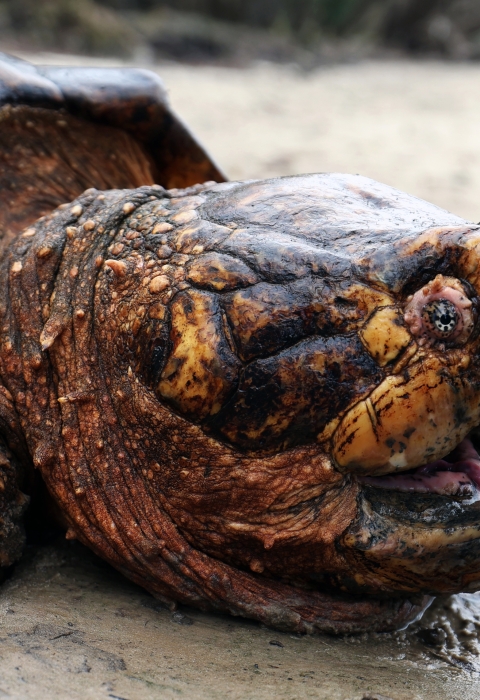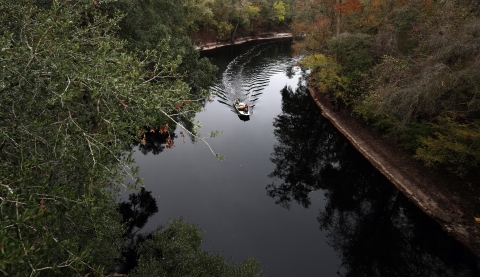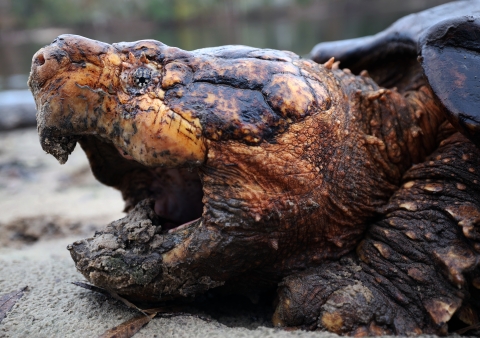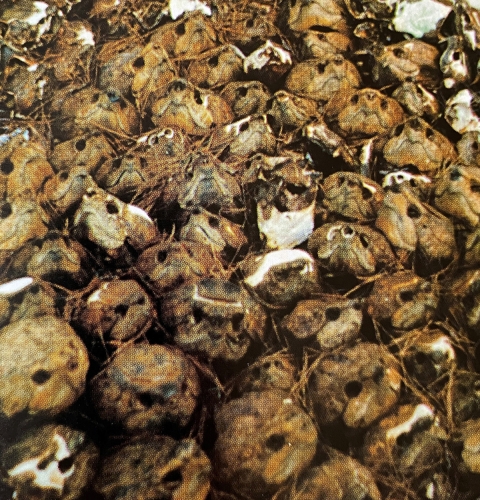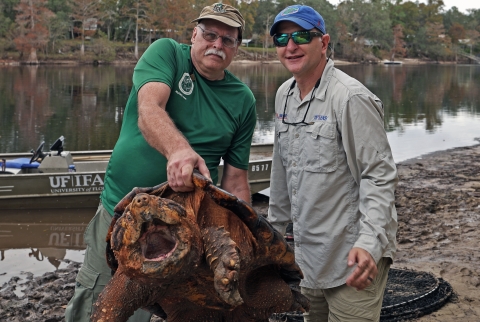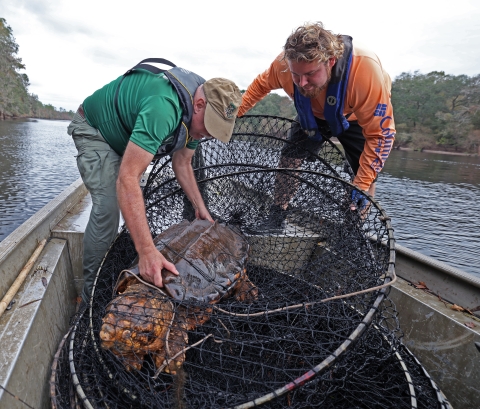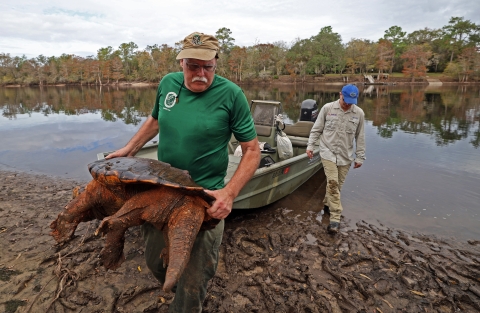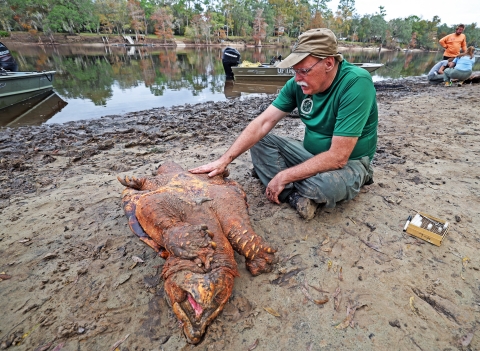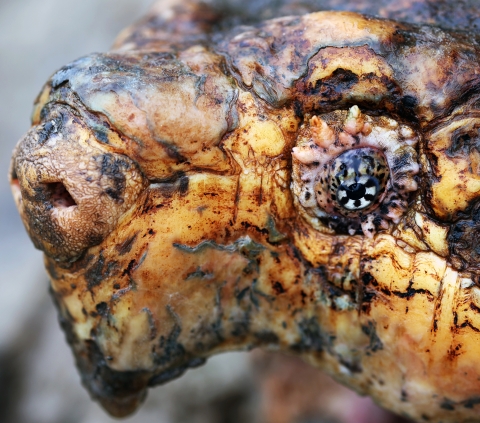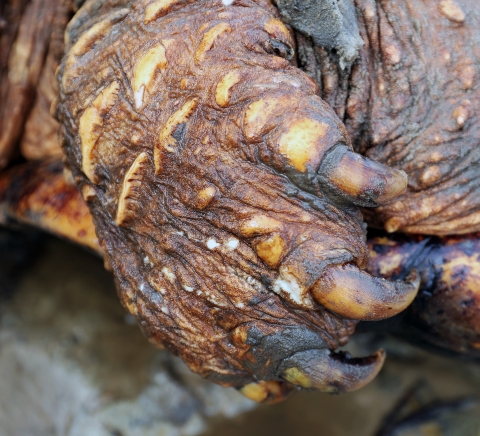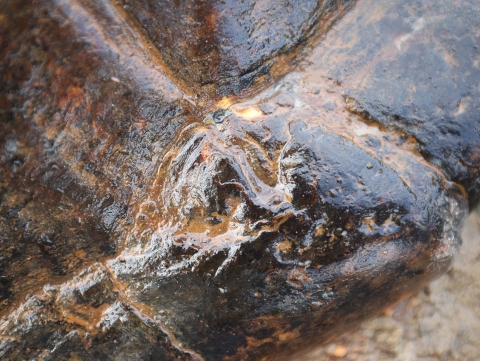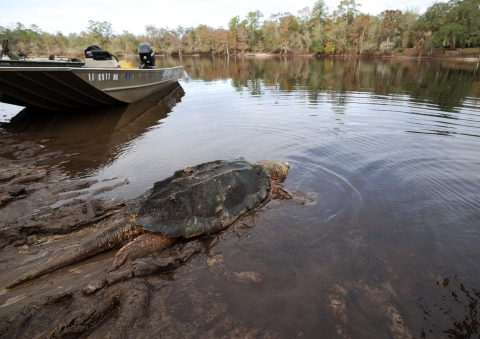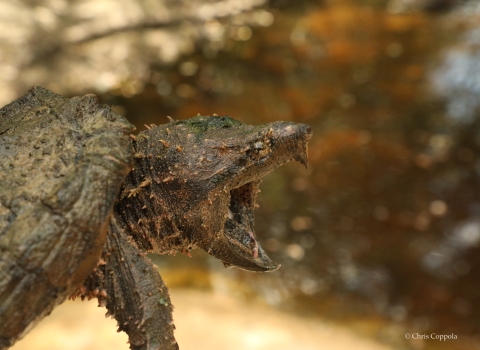Deep in the waters of the Suwannee River basin, the T-Rex of turtles lies in wait. Thick ridges run down the length of his massive, armored shell ending in a tail almost as long as his body. A wedged head supports massive jaws ending in hooked beaks. His mouth agape, a worm-like appendage atop his tongue lures unsuspecting prey.
Only found in the Suwannee River basin of Georgia and Florida, a golden tint colors the Suwannee alligator snapping turtle while a wide, crescent-shaped notch at the back of its shell distinguishes it from other alligator snapping turtles. Suwannee snappers are nocturnal, and rarely leave the water, nesting females and juveniles occasionally venture overland. Among the largest freshwater turtles in North America, they look fierce, but in the water, they are secretive giants.
Unfortunately, in the late 1960s a fad for turtle soup led to overhunting, and they were almost eaten out of existence. Georgia trapper Al Redmond alone caught 10,000 in the Flint River in eight years. Later, he dedicated himself to breeding and releasing them, but the damage had been done.
Georgia prohibited hunting the turtles in 1992 and Florida followed in 2009. The snapping turtles haven’t recovered because of their slow maturation and reproduction rates. Accidental deaths from fishing, hook ingestion, habitat alteration, and nest predation further threaten the animals. Groundwater withdrawal and nitrate pollution from agriculture threaten water levels, quality, and turtles in much of the Suwannee basin.
In 2021, the U.S. Fish and Wildlife Service proposed listing the turtles as threatened under the Endangered Species Act. In June 2024 the agency made that listing final.
Enter the gator turtle trapping team of Travis Thomas and Kevin Enge, known for their snapper scholarship and exploits.This year marks the duo’s 15th anniversary of wrangling Suwannee alligator snapping turtles to conserve and protect them. Thomas caught his first turtle under the guidance of Professor Jerry Johnston, which led him to work with Enge, a wildlife biologist with the Florida Fish and Wildlife Conservation Commission. Thomas is now a research assistant professor at the University of Florida where he teaches quantitative ecology and wildlife techniques.
Enge said scientists didn’t know much about Suwannee turtles when they started. Now they do, including population, distribution, and stability of the species. But there is still a lot they don’t know, like the numbers and locations of nesting sites or where the hatchlings live. Enge said the hatchlings probably occupy smaller streams and hide in woody and vegetative cover in shallow water or the floodplains of larger streams where he and Thomas can’t trap them. The trap's mesh is too large to catch turtles until they are at least a couple of years old.
Enge and Thomas monitor six sites in Florida, setting traps in spring, summer, and fall. Over the years they have gathered long-term recapture data to understand growth rates and survival, and to calculate population estimates and trends.
This helps the U.S. Fish and Wildlife Service decide if the turtles require protection under the Endangered Species Act, alerts the agency of threats, and shows the need for habitat improvements.
“The Suwannee River is top-notch for them,” said Thomas. The turtles favor undercut banks and resting in the shallow water among big tree roots and submerged debris. The clean spring-fed water that feeds the river reduces its acidity and provides a plentiful food supply of shellfish, fish, reptiles, and amphibians.
On the river, Thomas typically helms the boat while Enge checks the traps. “Stay out of the way and watch out—they have a bitey end,” said Thomas. He navigates the boat alongside a submerged tree while Enge unties and hauls in the baited hoop nets, carefully extracting the turtles. They work quickly to minimize the stress on the animals.
Enge has been bitten only once carrying out his duties—a 104-pound snapper, who gave him a bruise that lasted three months. He and Thomas were transporting the animal to his office to measure its bite force when it happened. Strolling by the gate of the pickup truck, the turtle reached through its trap and bit Enge in the hip. “We found out later that it had a bite force of 1000 pounds per square inch, but fortunately, it just nipped me,” he said.
On the sandbank, a welcoming committee of biologists and veterinarians stand by to measure each turtle’s carapace (upper shell) length and width, head width, plastron (belly) and tail length. They also weigh the turtle. Helpers admire the largest male caught that day, weighing in at 127 pounds. Thomas estimated him to be around 60 or 70 years old. “We don’t know how long they live because they outlive the researchers,” he said.
Biologists inject a microchip tag into the tail and drill small holes along the rear edge of the shell, assigning a unique code to identify individuals when they are recaptured. Once processing is over, the workers release the turtle, watching and recording him on phones as he lumbers over the wet sand and glides slowly back into the river and under the water.
Enge is cautiously optimistic about survival prospects for this formidable prehistoric creature. “They are no longer harvested. A lot of the watershed is protected,” he said. Today, their biggest threats are accidental hooking from fishing and groundwater withdrawal decreasing flows in the Suwannee River. Over the years Enge and Thomas have probably caught more than 300 turtles, but it doesn’t get old. “It’s still exciting when we get a big one,” Enge said.
